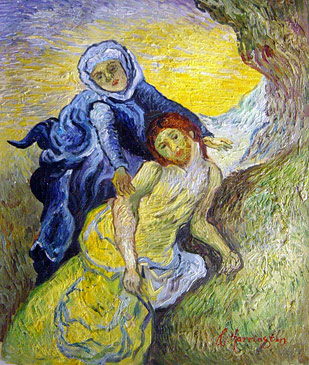This summer, the York St John Literature programme invited students and staff to read and respond to Colm Tóibín’s 2012 novella The Testament of Mary, a study of the mother of Jesus of Nazareth as she comes to terms with her son’s crucifixion at hands of the Roman Empire. Building upon Adam’s post yesterday, here Nicoletta Peddis explores the power of testament to subvert and undermine our perception of a major biblical character.
By Nicoletta Peddis
Testament (n.) late 13c.: “last will disposing of property,” from Latin testamentum “a last will, publication of a will,” from testari “make a will, be witness to,” from testis “witness.” Used in reference to the two divisions of the Bible (early 14c) (…) subsequently was interpreted as Christ’s “last will.” (from Online Etymology Dictionary).
In the Gospels, the Virgin Mary is the personification of grace and suffering, the mater dolorosa who is largely voiceless. We know little about her, except for her virginity and her grief. Colm Tóibín’s short novel The Testament of Mary gives voice to Mary, subverting the traditional representation of Jesus’s mother and at the same time expanding the definition of the term testament. The Testament of Mary is her giving witness to, her attestation; “I was there,” she says. The fictional portrait that Tóibín creates of Mary breaks with tradition to deepen her humanity and to bring her down to earth, trying to understand her as a suffering woman and as a mother afflicted with a difficult son.
 From the first page, it is the raw first-person voice of the human Mary that meets the reader to tell her painful story. Mary recounts her love for her son, but also, and more importantly, her human reactions and the limits of the bond with her son; “the pain was his and not mine”, she says, abandoning herself to the moment of honesty and weakness that she is not allowed in the Gospels. Tóibín enriches the traditional portrait of Mary’s stoicism in grief and subverts the traditional representation of the Pièta in which the Virgin Mary holds Jesus’ corpse in her arms. In Tóibín’s Pièta the readers hold the mother in their arms and listen to her testimony.
From the first page, it is the raw first-person voice of the human Mary that meets the reader to tell her painful story. Mary recounts her love for her son, but also, and more importantly, her human reactions and the limits of the bond with her son; “the pain was his and not mine”, she says, abandoning herself to the moment of honesty and weakness that she is not allowed in the Gospels. Tóibín enriches the traditional portrait of Mary’s stoicism in grief and subverts the traditional representation of the Pièta in which the Virgin Mary holds Jesus’ corpse in her arms. In Tóibín’s Pièta the readers hold the mother in their arms and listen to her testimony.
Tóibín chooses to employ a poetic language, with Mary describing in cold and vivid detail the crucifixion. The language of the short novel is also cryptic, with implication rather than explication employed to affect the reader. Significantly, the name Jesus is never used and neither is Christ. Instead, Mary calls him “my son” or “him” or “the one who was here.” This is because of her grief (she cannot even bear to say the name) but it is also because she refuses to participate to the creation of the narrative of the man named Jesus Christ. Mary only heard stories about her son curing the sick, raising the dead and turning water into wine. In her testament, Mary wants to speak the truth only; “the truth should be spoken at least once in the world”, she says, despite the insistence of her son’s mysterious followers who visit her in Ephesus, where she hides after Christ’s crucifixion.
The unidentified visitors, whose identity is left ambiguous, intimidate her, wanting her to confirm the story of Jesus’ divinity. But Mary refuses, knowing that the scribe has “written of things that neither he saw nor I saw.” The opposition between their blind insistence and Mary’s scorn is portrayed in the dialogues: ‘Saved from death?’ I asked. ‘Saved for eternal life,’ he said. ‘Everyone in the world will know eternal life.’ ‘Oh, eternal life!’ I replied. ‘Oh, everyone in the world.’ The use and repetition of the word “oh” casually diminishes the greater words “eternal” and “everyone” thus marking the enormous gap between the mother and the writers.
The Testament of Mary finally gives the mother of Jesus a chance to speak. And, in Tóibín’s vision, she uses the chance to reveal the way in which her son became a stranger to her, her realization that he was doomed, and how she never shared the conviction that he was going to rise again. She reveals how she abandoned the place of crucifixion to protect herself from the menaces of the persecutors of her son as well as from his followers. Moreover, having seen the crucifixion, Mary tells the apostles: “I can tell you now, when you say that he redeemed the world, I will say that it was not worth it.” Mary uses the chance that Tóibín gives her to discard the ways in which she has been traditionally described and to reveal herself in all her humanity.
